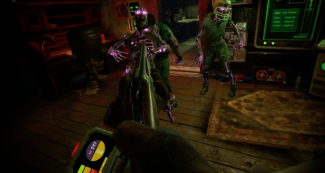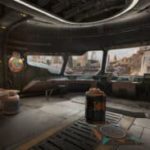Drop Dead: The Cabin brings a co-op zombie wave shooter to Quest 2 today, and we were recently joined by developer Soul Assembly for a hands-on preview.
Reminiscent of Call of Duty Zombies, Drop Dead: The Cabin takes a different approach to its on-rails predecessor, Drop Dead: Dual Strike. Playable solo or in two-player co-op, your goal involves fending off undead hordes to secure your extraction, but don’t take this lightly. Joined by Soul Assembly’s publishing manager, Joe Waterworth, and lead game designer, Jim Norris, I played two rounds of co-op before interviewing the duo.
Every run begins in the cabin’s living room, providing brief preparation time before the hordes arrive. Each player can holster four weapons at once, ranging from smaller items like knives and revolvers to hefty baseball bats, but be careful; ammo is limited, melee weapons are durable and zombies can spawn from every direction. Resource management and movement are key to survival, staying put isn’t an option.
Progression is gated behind locked doors, which are unlocked by obtaining points earned through killing zombies. Once you have enough, grab the door handle and wait for it to open. Eventually, you can head into the forest and restart the power generator, achieved by finding fuel cells, to secure your extraction. Because Soul Assembly’s incorporated roguelike elements, ammo, swarm points and fuel cells spawn in different locations, so no two runs are alike.
“You constantly have to look around and find out: get your bearings, get your ammo, get your weapon, get your fuel,” Waterworth tells me afterwards. “The core base of The Cabin is what you saw [during this preview], but every time it remakes, it’s about going back Groundhog Day-style and improving your skills, getting more knowledge of the gameplay world and where things spawn.”
My time was brief but I enjoyed what I’ve played; there’s a straightforward yet challenging gameplay loop that kept me on my toes. There were moments where I struggled to pick up items using its magnetic grab, though Norris says this might get looked at. After finishing the playthrough, Waterworth informed me that gameplay may expand post-launch. He doesn’t outright confirm the next steps, but he gives an idea of what future updates could bring.

“As we move towards post-release content, we can remix more weapons in there, we can look at expanding different areas and keep that gameplay fresh, adding more modes to it.”
Unfortunately, I didn’t come close to escaping on either attempt. I quickly ran out of ammo and melee weapons. Teammates can be revived by high fiving each other but the hordes eventually swarmed us both. You can only sprint so many times before your stamina depletes, though I enjoyed the silliness of fending off zombies with plates and cutlery.
The Cabin thrives on replayability, so my losses weren’t surprising. Exp is awarded upon finishing a run and that gradually levels up individual aspects. Ammo can be grabbed from a greater distance, health items restore more HP, there’s larger ammo reserves, doors unlock quicker and plenty more. You probably won’t win on your first try but practice eventually makes perfect.
This isn’t just a VR take on Call of Duty Zombies, despite similarities in its premise. The Cabin doesn’t strive for visual realism, evidenced by the Quest version using Meta avatars for characters and bright neon zombies dressed in sports gear. The 80s aesthetic and colorful enemies contrast nicely against this ominous horror setting, even though avatars feel tonally out of place. Norris informs me there’s many Stranger Things fans within Soul Assembly and he credits the team’s art lead, Gareth Morrison, for this approach.
Everyone’s all about the 80s right now… Stranger Things is huge, retro music is really huge, retro gaming is really huge. When you think about horror movies of that time, there’s always a cabin. There’s always some preppy dude that ends up getting eaten by the monster first. So, we wanted to bring in all these different elements of pop culture from that period that we really liked. We liked the bright color aesthetic, so that’s why you see the purples and the greens.

That’s reflected through an upbeat soundtrack too, for which Norris praises sound designer Giorgio Carlin. “We brought Giorgio in and he was like, “let me make some fighting music for this. That really gets the heart pumping. You’re getting in the zone, head shotting to the beat.”
Drop Dead: The Cabin arrives on Meta Quest 2 today, while the Pico 4 version launches later this year. Waterworth confirms there’s no further platforms planned right now, stating there’s no enhancements for Meta Quest Pro either, though he admits both could always change.
“That’s all we’ve got planned for right now. But we’re open to where we want to take the game in the future, maybe PSVR? It’s up for debate and we’ll see how things go.”





